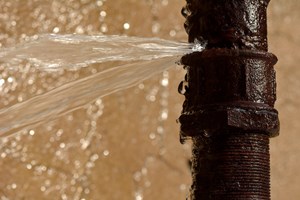Vermont to use $200 million in federal funds to restore aging water infrastructure
(UC) — Governor Phil Scott and Agency of Natural Resources Secretary Julie Moore on Tuesday visited the Royalton Water Treatment Facility project and highlighted the substantial investments secured this year in water, sewer and stormwater infrastructure, and climate resiliency.
While at the facility, Governor Scott detailed his plan to use $1 billion in funding provided from the American Rescue Plan Act (ARPA) to serve Vermont.
“We put forward the package we did because to get the transformative results from the once-in-a-generation opportunity ARPA has given us, we need these initiatives to complement each other,” Gov. Scott said.
He intends to use $200 million from the fund to invest in water, sewer and stormwater infrastructure projects, $250 million for broadband infrastructure, $250 million for housing, over $200 million to combat climate change and roughly $170 for economic development.
“Water, sewer, and stormwater infrastructure projects can inject new life into the rural parts of our state and my administration is committed to making sure these projects, as well as other investments we’re making, benefit all of Vermont’s 14 counties, not just the Northwest part of the state,” the governor said.
According to Secretary Moore, the challenge with water infrastructure is that since it generally out of sight and therefore out of mind, she said as a result the pace of investment in these assets does not stayed in pace with the need.
“Water infrastructure is the backbone of our lives and livelihoods,” Secretary Moore said. “From turning on the tap in the morning to take a shower, to preparing the food we eat, to the proper drainage of our roads and parking lots on rainy days, and to having sufficient clean water and wastewater treatment capacity to support local businesses and institutions. It is all water infrastructure!”
In many Vermont communities, water infrastructure is the most valuable asset the community owns – more than the local school and often more than the network of town roads, she noted.
The Secretary estimated that across Vermont there is more than $2 billion of investment needed in drinking water, wastewater and stormwater systems needed over the next 10 years, to both refurbish existing systems and to prepare essential infrastructure for increasingly disruptive and potentially devastating effects of climate change.
Additionally, Vermont’s aging and rural populations are especially challenged by the costs associated with maintaining, upgrading and replacing aging water infrastructure while keeping user rates affordable.
Fortunately, unprecedented financial resources have become available to invest in water infrastructure in the state, which includes the Clean Water State Revolving Fund program, which is an EPA partnership that provides communities low-cost financing for a wide range of water quality infrastructure projects.
Additionally, Vermont has committed to invest nearly a quarter of the discretionary funding it received in federal American Rescue Plan – or ARPA – funds in drinking water, wastewater and stormwater infrastructure projects.
All told, over the next five years, working with community partners and homeowners, Vermont is on track to invest nearly three-quarters of a billion dollars in water infrastructure projects.
The Royalton Water Treatment Facility Project is an example of both the type of investment needed and the opportunities infrastructure investment offer, Secretary Moore stated.
“The overall purpose of this project is to upgrade the Royalton water treatment plant which is quickly approaching the end of its useful life and is increasingly becoming more difficult to operate,” she added.
The project will ensure that the Royalton water system can adequately and reliably supply its customers with safe drinking water in the face of a changing climate while providing additional capacity need to support future growth.
The Royalton water systems is one of the few in Vermont that uses a river – the White River – as its main source of supply.
The investments that are underway will ensure that the water system is able to provide consistent, high quality drinking water for users and respond to a wider range of conditions in the river, such as lower flow during drought conditions, or the conditions being experienced in much of the northeast right now from major rain events that can negatively impact water quality.
Related News
From Archive

- Glenfarne Alaska LNG targets late-2026 construction start for 807-mile pipeline project
- U.S. water reuse boom to fuel $47 billion in infrastructure spending through 2035
- $2.3 billion approved to construct 236-mile Texas-to-Gulf gas pipeline
- Major water pipe break in Puerto Rico hits over 165,000 customers
- Potomac River Tunnel project enters construction phase beneath Washington, D.C.
- Pennsylvania American Water launches interactive map to identify, replace lead water service lines
- Trump's tariffs drive $33 million cost increase for Cincinnati sewer project
- Utah city launches historic $70 million tunnel project using box jacking under active rail line
- Tulsa residents warned after sewer lines damaged by boring work
- Fatal trench collapse halts sewer construction in Massachusetts; two workers hospitalized




Comments